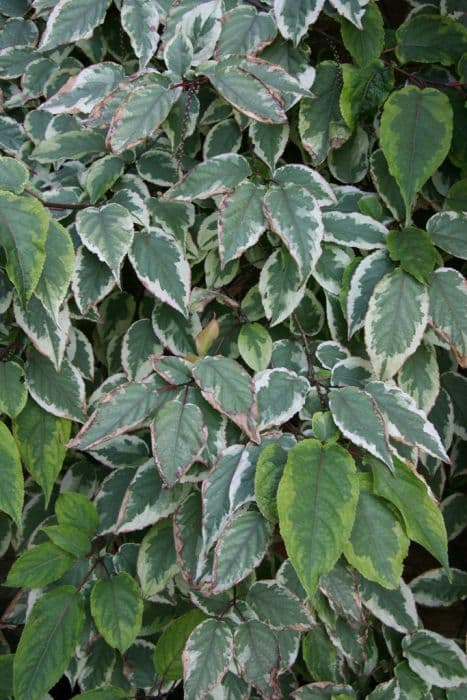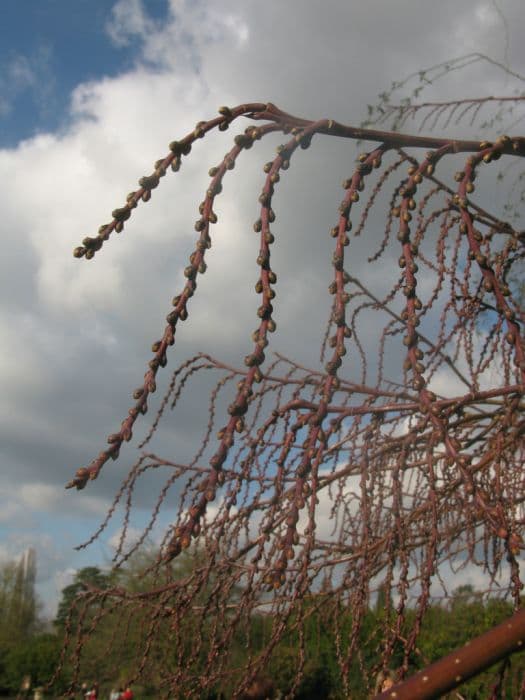Spike Tail Stachyurus chinensis 'Joy Forever' (v)

ABOUT
The plant known as 'Joy Forever' has distinctive characteristics which make it noteworthy in the garden throughout different seasons. It features variegated leaves that are edged with a yellow border, giving it a striking appearance and providing visual interest. As the seasons change, so does the foliage, with colors transitioning from pinkish hues in spring to creamy yellow later in the growing season. In the early spring, this plant produces pendulous racemes with small, bell-shaped flowers that dangle elegantly from the branches. These flowers are typically a soft yellow hue, adding a splash of gentle color against the variegated leaves. As the flowering season ends, the plant continues to hold interest with its vibrant foliage that remains appealing before the leaves drop in the fall.
About this plant
 Names
NamesFamily
Stachyuraceae
Synonyms
Chinese Stachyurus, Spiketail
Common names
Stachyurus chinensis 'Joy Forever' (v).
 Toxicity
ToxicityTo humans
There is limited specific information available regarding the toxicity of Spiketail (the most common name for Stachyurus chinensis) to humans. In general, Stachyurus species are not known for being highly toxic. However, as with many ornamental plants, it is advisable to avoid ingesting any part of the plant due to the potential for mild stomach upset or an allergic reaction. There is not enough documented evidence of severe poisoning or significant symptoms associated with this particular plant.
To pets
Similar to the information available for humans, there is limited specific information on the toxicity of Spiketail to pets. Stachyurus species like Spiketail are not typically reported to be highly toxic to pets like cats and dogs. Nevertheless, ingestion of plant material by pets can sometimes lead to gastrointestinal discomfort, including symptoms like vomiting or diarrhea. If a pet consumes part of the plant and exhibits any adverse reactions, it's best to consult a veterinarian.
 Characteristics
CharacteristicsLife cycle
Perennials
Foliage type
Deciduous
Color of leaves
Variegated
Flower color
Yellow
Height
6-8 feet (1.8-2.4 meters)
Spread
4-6 feet (1.2-1.8 meters)
Plant type
Shrub
Hardiness zones
6
Native area
China
Benefits
 General Benefits
General Benefits- Ornamental Value: Stachyurus chinensis 'Joy Forever' adds aesthetic appeal to gardens with its variegated foliage and pendant racemes of yellow flowers that bloom in early spring.
- Seasonal Interest: This plant has year-round interest with leaves that change color throughout the seasons – from pink-tinged when young to green and white, and then to purple in the fall.
- Wildlife Attraction: The flowers provide an early source of nectar for bees and other pollinating insects, while birds may be attracted to the habitat provided.
- Low Maintenance: Once established, it is relatively easy to care for, requiring minimal pruning and can grow well in a range of soil conditions.
- Hardiness: Being a hardy plant, it can withstand low temperatures, making it suitable for various climates and useful in landscaping for year-round structure.
- Adaptable: Stachyurus chinensis 'Joy Forever' is adaptable to different levels of light, from full sun to partial shade, allowing it to thrive in various garden locations.
 Medical Properties
Medical PropertiesThis plant is not used for medical purposes.
 Air-purifying Qualities
Air-purifying QualitiesThis plant is not specifically known for air purifying qualities.
 Other Uses
Other Uses- Photography Accent: Stachyurus chinensis 'Joy Forever' can be used as a stunning backdrop or accent in garden photography due to its variegated leaves and drooping racemes of flowers.
- Crafts: The flexible stems of the Spiketail can be used in floral crafts, such as wreath-making, where they provide a unique texture and color to the overall design.
- Educational Tool: Educators can use the Spiketail in lessons about plant variegation, demonstrating how it can occur naturally in plant leaves.
- Seasonal Decoration: Its branches, with leaves and sometimes with seed pods, can be collected and used for autumnal or spring table decorations.
- Landscape Design Tool: The plant can serve as an example of how to use variegation to create depth and contrast in landscape design.
- Privacy Screen: When planted in a row, Spiketails can create a semi-transparent privacy screen that changes throughout the seasons.
- Sound Barrier: The dense foliage can help to dampen noise when planted along a busy road or between properties.
- Boundary Marker: Spiketail can be used to demarcate property lines or garden sections in a visually appealing way without the use of fences or walls.
- Artistic Inspiration: Artists may use the plant as a muse or subject matter for paintings, drawings, or sculpture, especially focusing on its striking foliage.
- Culinary Garnish: Although not commonly used for consumption, the attractive foliage might be used as a garnish for plating in high-end culinary presentations.
Interesting Facts
 Feng Shui
Feng ShuiThe Chinese Stachyurus is not used in Feng Shui practice.
 Zodiac Sign Compitability
Zodiac Sign CompitabilityThe Chinese Stachyurus is not used in astrology practice.
 Plant Symbolism
Plant Symbolism- Renewal: Stachyurus chinensis, commonly known as Chinese Stachyurus, often blossoms in early spring, symbolizing the end of winter and the beginning of a new cycle of growth.
- Hope: Its early blooms can be a symbol of hope, as it is one of the first plants to flower at the end of the cold season, bringing optimism for the coming warmth and abundance.
- Beauty: With its elegant cascading flowers, the Chinese Stachyurus is often associated with aesthetic beauty, symbolizing the appreciation for nature’s artistry.
 Water
WaterThe Chinese Stachyurus 'Joy Forever' prefers consistent moisture, so it's important to water it deeply about once a week, or when the top inch of soil feels dry to the touch. During the growing season in spring and summer, you may need to increase watering to twice per week, especially in dry conditions. Each watering should be thorough, providing the plant with one to two gallons of water to ensure it reaches the roots. In winter, reduce watering to every two weeks or whenever the soil is dry as the plant enters a dormant period.
 Light
LightChinese Stachyurus 'Joy Forever' thrives in a spot that receives full sun to partial shade. The ideal location would provide morning sunlight with some afternoon shade to protect the plant from the intense heat of the day. Ensure it gets at least four to six hours of sunlight daily to promote healthy growth and flowering.
 Temperature
TemperatureThe Chinese Stachyurus 'Joy Forever' grows best in temperatures between 50°F and 75°F. It can tolerate short periods of colder weather down to about 20°F but should be protected from prolonged freezing temperatures. During summer, ensure it is not exposed to temperatures above 90°F for extended periods, as extreme heat can cause stress to the plant.
 Pruning
PruningChinese Stachyurus 'Joy Forever' should be pruned to maintain its shape and remove any damaged or dead branches. Pruning is best done after the plant has finished flowering in late spring or early summer. This practice encourages new growth and helps keep the plant looking tidy. Pruning is generally needed once a year unless growth is excessive or shaping is required.
 Cleaning
CleaningAs needed
 Soil
SoilThe Chinese Stachyurus 'Joy Forever' prefers well-draining soil with a mix of loam, peat, and sand. The pH should be slightly acidic to neutral, ideally ranging from 5.5 to 7. It benefits from a layer of mulch to maintain consistent soil moisture.
 Repotting
RepottingThe Chinese Stachyurus 'Joy Forever' should be repotted every 2 to 3 years. It's best to repot in the spring before new growth begins, allowing the plant to establish in its new container.
 Humidity & Misting
Humidity & MistingThe Chinese Stachyurus 'Joy Forever' thrives in moderate to high humidity levels. Aim for humidity around 50-60% for optimal growth. Avoid placing it in overly dry environments.
 Suitable locations
Suitable locationsIndoor
Place near bright, indirect light; ensure moderate humidity.
Outdoor
Plant in partial shade; shelter from strong winds; mulch base.
Hardiness zone
6-9 USDA
 Life cycle
Life cycleStachyurus chinensis 'Joy Forever', also known simply as Stachyurus, begins its life cycle when the seed germinates in the soil, typically in late spring or early summer. The seedling then develops into a young plant with a rosette of leaves close to the ground during its first growing season. As the plant matures, it forms a woody stem and begins to exhibit its characteristic shrub form. Each year, the Stachyurus grows new branches and leaves, and eventually produces pendulous chains of bell-shaped flowers in late winter to early spring before the leaves emerge. After pollination, usually by insects, the flowers develop into fruit capsules that contain the seeds for the next generation. Once matured, the plant enters a period of dormancy during the cold winter months, conserving energy for the next growing season.
 Propogation
PropogationPropogation time
Spring to Early Summer
The Stachyurus chinensis 'Joy Forever', commonly known as the Chinese Spikenard, is often propagated by semi-hardwood cuttings. This method is most successful when conducted in late summer. To propagate by this method, a gardener would cut a length of stem that has matured slightly but is not yet fully hardened—it should still be somewhat flexible. This cutting, typically 4 to 6 inches (about 10 to 15 cm) long, should include at least two sets of leaves. The lower leaves are removed and the cut end dipped in rooting hormone to encourage root development. This treated cutting is then inserted into a pot filled with a well-draining soil mix. The cutting needs to be kept moist and in a warm environment with indirect light until roots have developed enough for the plant to be transplanted into the garden or a larger pot.


